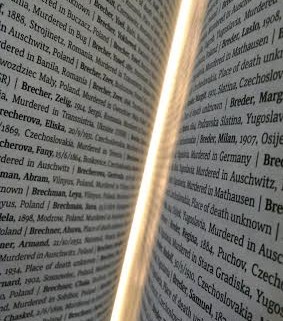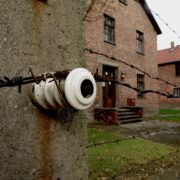A Visit to Auschwitz
By Kylie Britt
As a student learning about the Holocaust, I never envisioned myself actually visiting the site where millions of people lived and died in the concentration camps. I never expected to walk under the haunting Arbeit Macht Frei, “work makes you free” sign to Auschwitz I, or follow the path of a deported prisoner through Auschwitz II- Birkenau. Despite the attempts to mentally and emotionally prepare myself for the experience, the visit left me feeling raw, angry, and perplexed, among other emotions. In this reflection I will attempt to explain the experience that is visiting Auschwitz by describing the physical site at the emotions felt as one travels through these vast camps.
The visit began with a tour of Auschwitz I where many of the blocks have been renovated into museum rooms exhibiting death certificates, deportation and arrival documents behind glass cases. The rooms are spacious and open in a simplistic design with the displays, signs and posters intentionally kept spaced out along the walls. On the wall of one room are the statistics of the 1,300,000 people deported to Auschwitz I, of which 1,300,000 died:
| 1,100,000 Jews |
| 140,000 Poles |
| 23,000 Gypsies |
| 15,000 Soviet Prisoners of War |
| 15,000 other ethnic groups |
In other rooms there are maps of the movement of the populations being deported to the camp. Scattered throughout the exhibits were quotes about Auschwitz and photographs of victims being removed from their homes and their arrival at the camps.
My tour group moved through each room of the exhibit in silence listening to the voice of our tour guide through our headsets as we climbed the wavered cement stairs, worn away at the center due to over use and excessive traffic. In some points of the tour, we were told to put our cameras away out of respect for the victims. Such was the case as we entered a room containing seven tons of human hair. Staring at a mound of hair I became numb, the hair was removed after the people were moved from the gas chamber by the Sonderkommandos. The hair was then packaged into sacks to be shipped and used in various ways. Our tour guide continued to explain how the hair was used as parachute strings, insulation of submarines, and for added warmth in the jackets of German soldiers. Hearing this broke the numb feeling of disbelief and replaced it with disgust at the methodical destruction of a people. The rooms that followed contained luggage, eye glasses, pots and pans, combs, brushes, shoes, broken children’s toys and clothes. All of these objects are so real, human, and vulnerable. Standing in a room with 40,000 shoes stolen from their wearers does not even come close to representing the 1.3 million people who died at this camp, but 40,000 shoes has an overwhelming presence when each pair represents a life that was lost.
When confronted with the evidence of these mass murders, it becomes difficult to focus on the amount of information that floods your senses thereafter. The rest of the tour moves quickly because management requires we finish our visit in one hour and forty minutes. The guide points to a wall in a court yard and tells us approximately 40,000 people were shot there. We learn that Block 11 was referred to as “the death block” and amongst other means of torture this is where the Nazis began to experiment with the gas chamber method of execution. Walking through the road between blocks we learned that when liberated, many children did not remember their names, only their assigned number tattooed on their arms. As we pass the medical block, we are informed that this is the location of some of the many experimental practices used in attempt to sterilize female Jews and learn the science behind producing twins. We passed the gallows where people were hung in front of masses of prisoners who were forced to watch. I try to imagine what it would been like to look out into the crowd from that place.
Block 27 now contains a new permanent exhibit prepared by Yad Vashem, the Holocaust documentation and remembrance center in Israel. One room is filled with the sounds and sights of the pre-war lives of many Jewish people. Their lives are commemorated in Block 27 as well as their deaths. In one room there is a giant book, the pages of whichfill a room, containing with the names of those who died as well as the location and dates of their deaths. We are shown the electrified barbed wire fence where many people made the desperate decision to run knowing they would be shot on the spot. We walked through the crematorium where thousands of corpses could be disposed of in hours. Just before leaving, overwhelmed by the raw emotion and numb disbelief that these horrors could be real, our guide left us with one final fact. Most prisoners weighed between 25 and 35 kg, no more than 78 lbs., a fact that resonated with me as we walked back to our bus. The atrocities that occurred were clear in Auschwitz I, but the best examples of the precision and efficiency of the Nazi elimination program was in Auschwitz II- Birkenau.
The sheer size of Auschwitz II -Birkenau is daunting. It can be best described as a camp inside of a camp. After walking along the train tracks that carried millions of innocent people to their deaths, we reached a building where the ‘lucky’ few who were selected to work rather than be sent directly to the gas chambers were examined and sanitized. We entered the building and walked the path of the frightened prisoners forced to strip and discard all remaining possessions before running through showers of an extreme temperature followed by burning hot steam. We then entered the room where their heads were shaved, taking away their last shred of individuality. Walking the path of this dehumanizing machine is astoundingly terrifying due to the impressive efficiency with which they worked. At the end of this torturous cleansing process in the last room where the prisoners would have received their uniforms, stood several walls covered in the photographs of the victims. These happy pre-war photographs revealed the humanity of these victims making it all so very personal, they reflected a life I could recognize. At another time or living in another place, these people could easily have been my grandparents, my parents, my family, my friends or me.
Leaving this portion of the camp, we passed the remains of two of the crematorium and gas chambers located on this work camp. Amongst the rubble and ruin that destroyed so many lives was a young fox. Further down the path was a rabbit near one of the old demolished bunkers. On this same walk, a large bird flew overhead, some guessed it was a stork others said a heron, but no matter what it was, I think it gave us all a bit of hope. Seeing nature rejuvenate and thrive in a place where so much pain has occurred is an inspiration that maybe we, too, can move on and thrive.
Finally, before we left we made one final stop at a bunker in one of the many camps. The bunker was the same as every nightmarish holocaust movie portrays them, cramped, dirty, and hard. Upon entering the bunker the contrast of the harsh features inside with the nature outside exemplyfiy the severe conditions in which these prisoners lived. This visit left me with the same questions I had tried to prepare myself to confront. How could someone do this? How is this type of mass killing possible? How could so many people go along with such evil ideas? The visit left my classmates and I as raw and emotional as expected, but if any of us expected clarity we were wrong. Whether you explore the topic with textbooks, memoirs, field trips, or conducting in-depth research I do not think we will ever be able to fully comprehend what has happened and why.
All attached photos were taken by Kylie Britt.














